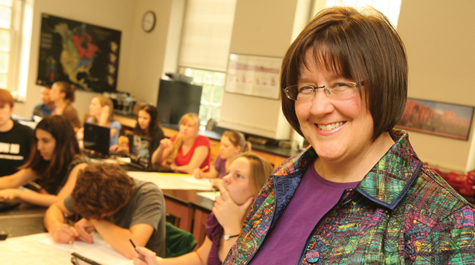STEM Outreach: A ‘cutting edge’ resource for geoscience teachers
Editor's note: This is one of a series of stories from Ideation magazine on the various STEM-outreach initiatives at William & Mary, programs that reach out beyond the walls of campus to increase understanding and appreciation of the STEM disciplines—science, technology, engineering and math. The full series of stories is available here.
Heather Macdonald has always been eager to get her new geosciences students out of the classroom and into the field—especially if there is a handy outcrop.
“Outcrops give us a great picture of what life was like in the past,” she says. “Here in Virginia, I take my students to an outcrop over in Chippokes State Park. We spend time looking at the sediments and the fossils. I love to see the moment when the students get what it means: This area was covered by an ocean millions of years ago. That’s a great conceptual leap.”
 Macdonald, Chancellor Professor of
Geology at William & Mary, likes to quote the writer John McPhee on how an
appreciation for outcrops and other aspects of geology allow us to ‘inhabit
scenes no one ever saw.’ In the years since joining the William & Mary
faculty in 1983, she has worked to increase the numbers of geologists
inhabiting unseen worlds by filling three overlapping roles: practicing
scientist, teacher to undergraduate students and mentor to early career faculty,
post-docs, and graduate students across the nation.
Macdonald, Chancellor Professor of
Geology at William & Mary, likes to quote the writer John McPhee on how an
appreciation for outcrops and other aspects of geology allow us to ‘inhabit
scenes no one ever saw.’ In the years since joining the William & Mary
faculty in 1983, she has worked to increase the numbers of geologists
inhabiting unseen worlds by filling three overlapping roles: practicing
scientist, teacher to undergraduate students and mentor to early career faculty,
post-docs, and graduate students across the nation.
Outcrops aren’t as handy to all of America’s teachers of earth science as they are in Virginia. In 2002, Macdonald joined a cooperative venture of like-minded geosciences faculty to launch On the Cutting Edge, a STEM-outreach program for fellow geoscience faculty. It’s a professional-development initiative that integrates a resource-rich website with a series of workshops around the country for current and future geoscience faculty. Macdonald’s collaborators for On the Cutting Edge are fellow geoscientists Cathryn Manduca of Carleton College, David Mogk of Montana State University and Barbara Tewksbury of Hamilton College. New members of the leadership team include Rachel Beane of Bowdoin College, David McConnell of North Carolina State University, Michael Wysession of Washington University and Katryn Wiese of San Francisco City College.
Several workshops each year
The group holds several workshops a year around the country as well as virtual workshops, online journal clubs, and webinars; a workshop for Early Career Geoscience Faculty is scheduled for William & Mary in summer of 2012. More than 2,000 faculty members, graduate students and post-docs from more than 450 colleges and universities have participated in Cutting Edge workshops.
The Cutting Edge website expands the functionality and reach of the workshops. The site was developed and is maintained at the Science Education Resource Center (SERC) at Carleton College, where Manduca is the director.
“The website is built from the workshops,” Macdonald explained, “but it also extends the reach of the workshops, making materials and ideas and resources accessible to geoscience faculty, both current and future.”
A one-stop source for landslides, earthquakes or tsunamis
The website contains information and materials organized into some 40 topical sections. The resources include more than 1,500 activities contributed by faculty in the geosciences. The activities include ideas for interactive classroom discussions, field exercises and lab activities. “If you are going to teach a class on landslides or earthquakes or tsunamis, you can go to our website and look for resources,” Macdonald said. “As you prepare for the class, you can see what other geosciences faculty have done on that topic.”
On the Cutting Edge has been a success by any measure, attracting $9 million in support from the National Science Foundation and a number of awards. In 2010, the American Association for the Advancement of Science (AAAS) recognized the web component of On the Cutting Edge with its Science Prize for Online Resources in Education (SPORE). Macdonald was a finalist for the 2012 Robert Foster Cherry Award sponsored by Baylor University, one of the top honors in American higher education.
 Skip to main content
Skip to main content

